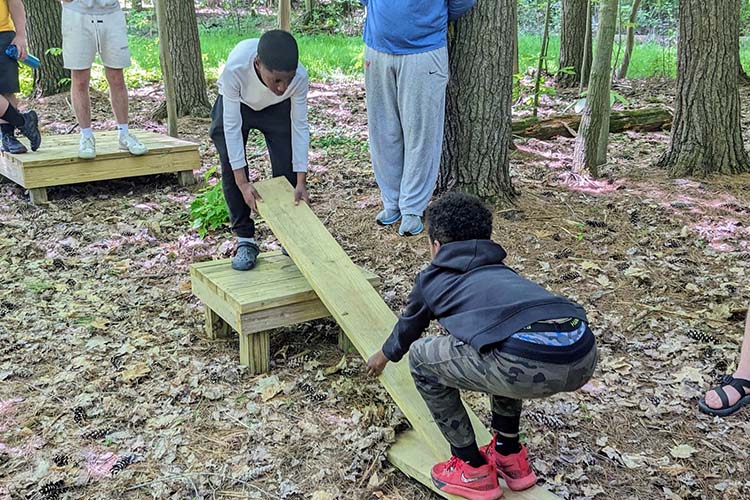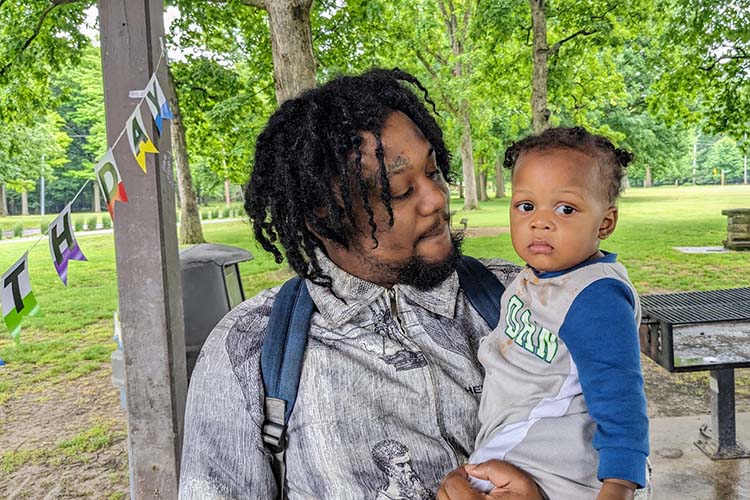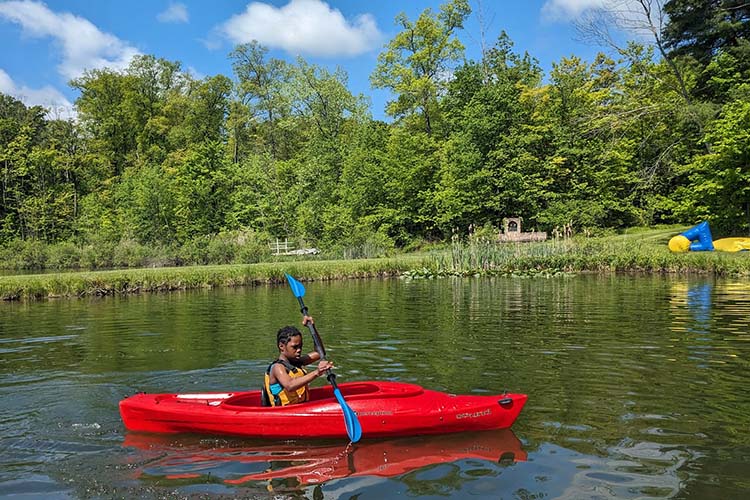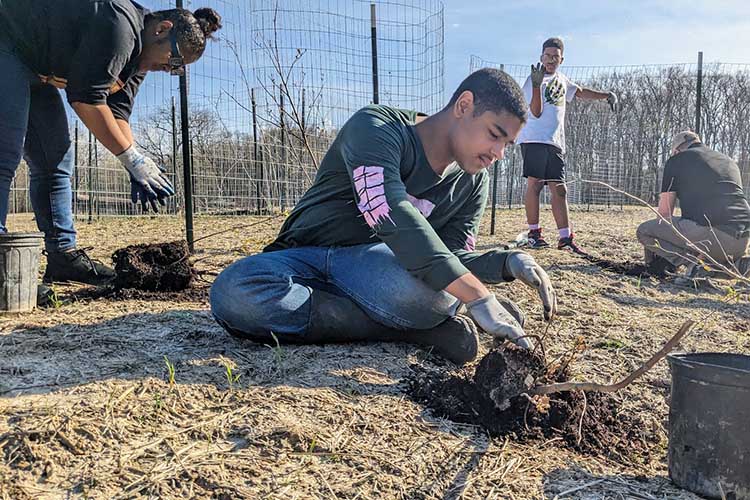Bridging the nature gap: Empowering urban youth with outdoor experiences
“That-a-way, Jamir!” counselor Connor O’Hara calls to a sixth grader halfway up a 50-foot climbing wall in the woods. “You got that one!... Go, Jamir, go!”
Slowly and carefully, Jamir Smith reaches the summit and descends. Then he returns O’Hara’s high-five gently. “My arms feel like noodles,” he says.
Jamir and many of his sixth-grade classmates from Cleveland’s Garfield School in West Park are new to the woods. They’re spending a weekend hiking, fishing, kayaking, and more at rustic Camp Ho Mita Koda in Geauga County’s Newbury Township. “It’s crazy to be in all this nature,” says Jamir. Crazy calm, that is. “It’s peaceful.”
 A Garfield School sixth grader plies the water at Camp Ho Mita KodaLeaders of dozens of local organizations are fighting what’s known as “nature deficit disorder.” Like so many other challenges, it especially afflicts minorities like Jamir.
A Garfield School sixth grader plies the water at Camp Ho Mita KodaLeaders of dozens of local organizations are fighting what’s known as “nature deficit disorder.” Like so many other challenges, it especially afflicts minorities like Jamir.
Quoting the title of a career guidebook published by Sustainable Forestry Initiative and Project Learning Tree, the leaders are trying to put more “Black Faces in Green Spaces.”
These activists are helping minorities ski, swim, bicycle, bird-watch, garden, farm, camp, play ball, paint murals, and enjoy many other activities in fresh air with huge payoffs in personal and community health.
But many minorities lack the exposure, money, gear, and guidance to enjoy nature more. Some also fear encounters with two-legged predators.
Outdoor advantage
Studies show that nature provides a remarkable range of benefits—providing physical, mental, educational, social, and other positive outlets. The nonprofit Children & Nature Network states on its homepage, “Nature makes kids healthier, happier and smarter.”
The same holds for grownups, too. For just a few examples, nature improves motor skills, bone health, attention, creativity, social ties, and community spirit, while reducing obesity, myopia, blood pressure, strokes, anxiety, and depression.
There’s much more room to play outdoors than indoors. And there are benefits just from sitting on a park bench, watching a stream burble, squirrels scamper, and goldfinches frolicking.
Nature teaches many subjects—including biology, physics, geology, meteorology, hydrology, and ecology. CollabRx, a new consortium of local organizations, is promoting the study of biomimicry: engineering inspired by nature’s designs.
Whatever the subject, students learn better outdoors and bring better skills back to the classroom, says Dr. David Margolius, Cleveland’s director of public health. While buildings are bound by walls and ceilings, nature is bound by land, water, and sky.
“When you look out onto the horizon, it reduces the inner chatter in your head,” he explains. Indoors, most things stay the same. Outdoors, many change fast. Leaves flutter. Hawks swoop. Storms give way to rainbows.
Walking in the Cleveland Metroparks’ Garfield Park Reservation, visitor David Richmond says, “You can smell different fragrances. Sometimes you run across a patch of wildflowers.”
 Isaiah Brown celebrates his son Nysere's first birthday at Garfield Park Reservati
Isaiah Brown celebrates his son Nysere's first birthday at Garfield Park Reservati
Most buildings are private. Most of nature is public and social—you can escape or mingle there. Birders share sightings. Fishermen show off catches.
Katarina Smiley, circle member of Sankofa Circle International who runs the Collinwood Community Garden at East 156th Street, says, “When you’re outside, you tend to be more social. You’re out of your element. You rely on the community.”
Get out
How much time do Americans spend outdoors? Statistics are few and varied.
A 2014 report said that only 12% of adults go outdoors nearly daily, and only 31% stay outside for at least an hour. A 2011 report stated that most children spend at least two hours outdoors on weekdays and four or more hours on Saturdays or Sundays.
 Local youths help the Cleveland Metroparks restore a forest at West Creek ReservationBut the Children & Nature Network homepage states that children average under 10 minutes per day outside. “And for many kids,” the site reads, “regular and safe access to nature is determined by race, income, identity, ability and postal code.”
Local youths help the Cleveland Metroparks restore a forest at West Creek ReservationBut the Children & Nature Network homepage states that children average under 10 minutes per day outside. “And for many kids,” the site reads, “regular and safe access to nature is determined by race, income, identity, ability and postal code.”
Our region has many popular parks, including a national one, the Cuyahoga Valley National Park (CVNP). The Cleveland Metroparks have been named the nation’s best big-city park system five times by the National Recreation and Park Association.
Cleveland has 155 municipal parks, and most residents live within a 10-minute walk of at least one.
Many local activists meet many youths who live within a mile of Lake Erie yet have never seen the lake. And a 2015 survey found that just 5% of the CVNP’s visitors were minorities, despite its proximity to Akron and Cleveland.
At least that rate far surpassed the average for all national parks, which is under 1%.
Attracting a diverse group
In the mid-20th Century, many African Americans, often coming from the rural South, joined minority or integrated retreats throughout Northeast Ohio like picnic groves, summer camps, ranches, stables, beaches and golf clubs, according to Green Book Cleveland, a restorative history project detailing Black entertainment, leisure, and recreation in Northeast Ohio.
Some travelers drew threats, rezoning, and gunfire. Private security workers brutalized Black guests several times at Euclid Beach Park over the years.
 Jamir Smith, a sixth grader at Cleveland's Garfield School, scales a climbing wall at Camp Ho Mita KodaNowadays, we have many conveniences at home. But some of these indoor conveniences are easy to take outdoors (where all of this article has been written). And GPS helps visitors safely navigate the wilds of nature.
Jamir Smith, a sixth grader at Cleveland's Garfield School, scales a climbing wall at Camp Ho Mita KodaNowadays, we have many conveniences at home. But some of these indoor conveniences are easy to take outdoors (where all of this article has been written). And GPS helps visitors safely navigate the wilds of nature.
In recent years, the Greater Cleveland Regional Transit Authority (RTA) has improved connections between neighborhoods and nature. It has boosted service at many parks to seven days a week, added paratransit pickup spots at some parks, made room for bicycles on its buses and train, and promoted trails and outdoor spaces near its Rapid stations.
Meanwhile, the Metroparks has been renovating and expanding its parks system to ensure greenspace is welcoming and accessible to everyone.
Recent or current projects near predominantly Black neighborhoods on the city’s East Side are moving forward, thanks in part to a $13 million gift from the Jack, Joseph and Morton Mandel Foundation.
Projects include connections between the Glenville and St. Clair Superior neighborhoods to the lakefront, South Gordon Park, and the East 72nd Street Fishing Area; construction on the Cleveland Lakefront Bikeway from East 9th to East 55th Streets; restorations in Garfield Park; adding trails in Euclid and Slavic Village; and a recreational island off North Gordon Park as part of a $300 million Cleveland Harbor Eastern Embayment Resilience Strategy (CHEERS) project.
“Cleveland Metroparks’ priority is equitable park access for all residents,” says Metroparks communications director Jacqueline Gerling. The Metroparks offers more than 7,000 programs each year—many of them free—such as soul concerts, West African drum circles, and urban line dances.
Like other national parks, the CVNP is trying harder to represent and serve local communities, according to Conservancy for the CVNP president and CEO Deb Yandala. She says she has diversified the staff and board and attempted to create events that appeal to a wide variety of audiences, such as the Rhythm on the River concert series.
The city of Cleveland spends anywhere from $4 million to $10 million each year improving its parks. Now it’s seeking input for a parks master plan over the next 15 years. Last month, Cleveland City Council approved a distinct department for parks and recreation, which had been under public works.
Access for children
The State of Ohio does not require recess at schools, but Cleveland city elementary schoolers get 20 minutes per day of it outdoors, “when weather is feasible.”
 Sixth graders from Cleveland's Garfield School tackle challenges in the woods at Camp Ho Mita KodaIn 2010, Ohio issued a Children’s Outdoor Bill of Rights. But Renee Boronka, director of conservation education & outreach at the Western Reserve Land Conservancy, says that the state did little to fulfill it.
Sixth graders from Cleveland's Garfield School tackle challenges in the woods at Camp Ho Mita KodaIn 2010, Ohio issued a Children’s Outdoor Bill of Rights. But Renee Boronka, director of conservation education & outreach at the Western Reserve Land Conservancy, says that the state did little to fulfill it.
Now she’s leading a coalition of local groups to create similar bills of rights to submit to city councils in Cleveland and Euclid. Her conservancy and others have also been helping to create parks in neighborhoods like Buckeye, Hough, Old Brooklyn, Euclid Beach, East Cleveland, and elsewhere.
These local efforts support a global mission. In 2015, the United Nations called for “universal access to safe, inclusive and accessible, green and public spaces, in particular for women and children, older persons and persons with disabilities” by 2030 in its Sustainable Development Goals
Dispelling assumptions
Despite all these improvements, activists and researchers say that many minorities are still daunted by natural attractions. According to a 2018 report by Case Western Reserve University's Community Innovation Network, “There is a cultural transmission of fear and stories from grandparents of finding friends and relatives who have been lynched in the woods.”
According to a 2020 Cleveland State University presentation given to the Doan Brook Watershed Partnership, “Interviewees and survey respondents frequently discussed the negative historical associations that many Black residents have—often across multiple generations—with ‘the woods’ and ‘the water or river,’ resulting in an aversion or even fear of such places.”
Ebony Hood, who runs the outdoors nonprofit Syatt (See You at the Top) with her family to expose youth to challenging sports, says, “To this day, I feel a fear of rural areas.”
Kim Woodford, founder and principal of the nonprofit Journey on Yonder, started her organization to connect minorities with nature. “The isolation and peace of nature that attract so many white folks terrify African Americans in the woods,” she says.
Some minorities report subtle discouragement in joining outdoor sports and activities.
Both Woodford and Kim Alexander, coordinator of grants and funded initiatives with the Girl Scouts of North East Ohio, say they often get unsolicited advice on how to carry the backpacks they’ve used for years.
“People are making comments as if you don’t necessarily belong,” says Woodford, adding that she once watched two Black friends at Hocking Hills State Park hike past a white man, who turned to his family and said, “Make America Great Again.”
Mary Macias, president, CEO, and cofounder of Footpath Foundation, which takes urban children to Ho Mita Kota and other retreats, says her organization gets kids from low-income urban neighborhoods outside, exposed to nature, and comfortable in their surroundings.
“We once had someone ask us, ‘What are you guys doing here?’” Macias recalls, adding that some children often wonder too. “It’s amazing how often they ask me, ‘Am I allowed to be here? Is it free?’”
In city neighborhoods, many Clevelanders fear letting unsupervised children walk to neighborhood parks or play there.
Activists say that new or improved parks in the city draw more people, building safety in numbers. But Ward 2 Cleveland City Council member Kevin L. Bishop, who is also chairman of the municipal services and properties committee that oversees parks, says the city needs to prioritize making sure every park visitor feels welcome and safe.
“We have to do a better job of policing our parks and making sure they’re family friendly,” he says. “If you see a bunch of adults drinking at the park, it’s definitely not an atmosphere that young children will feel comfortable in, and definitely not their parents.”
In Cleveland and elsewhere, some concerts, football games, protests, and other outdoor events have turned violent or been canceled in fear.
Getting acclimated
Any new environment can be intimidating. Leaders say youngsters who are first encountering nature tend to worry about mud, bugs, prickers, bears, and monsters. Soon, though, they’re running, splashing, hooking worms, and having fun.
Two Garfield sixth graders say they love the wilds at Camp Ho Mita Koda.
Santana Miller says, “You get to see more animals, more plants, more rocks.” Jacob Thompson marvels that outdoor environments offer, “less internet and more nature.”
Their teacher, Rachel Williams, says, “It’s amazing to see them out of their comfort zone, being a little scared but enjoying the sunshine and the water.”
Leaders say that many urban young people are surprised to find berries, mushrooms, asparagus, and other foods growing outdoors, instead of finding the produce in stores. They’re also stunned by nature’s size.
“There was a huge green field,” Footpath Foundation’s Macias recalls. “This little boy was ‘Whoa, look at all that space! Why is it there?’ Macias replied, “It’s for hanging out, running around, whatever you want.”
The boy asked, “Can I run in it?” She approved, and he started running.
After Footpath adventures, participants have written comments like, “Being outside made me feel better about myself. It makes me feel more appreciative and caring.... Feels like I can breathe more and have fun.... I feel like Mother Nature loves me.”
The essentials
When going outdoors, don’t forget your sunhat and sunscreen. Darker skin resists sunburns and skin cancers somewhat—but not enough to prevent either condition—or these conditions can be harder to detect.
Reggae icon Bob Marley died from skin cancer that spread to his brain, liver, and lungs. There are specialized sunscreens for darker complexions.
One you’re protected, activists say everyone should plunge in and enjoy the outdoors. Get dirty, sweaty, and refreshed.
“Nature gives you an opportunity to stop and think and focus,” says Syatt’s Hood. “It allows you to put the world in perspective.”






